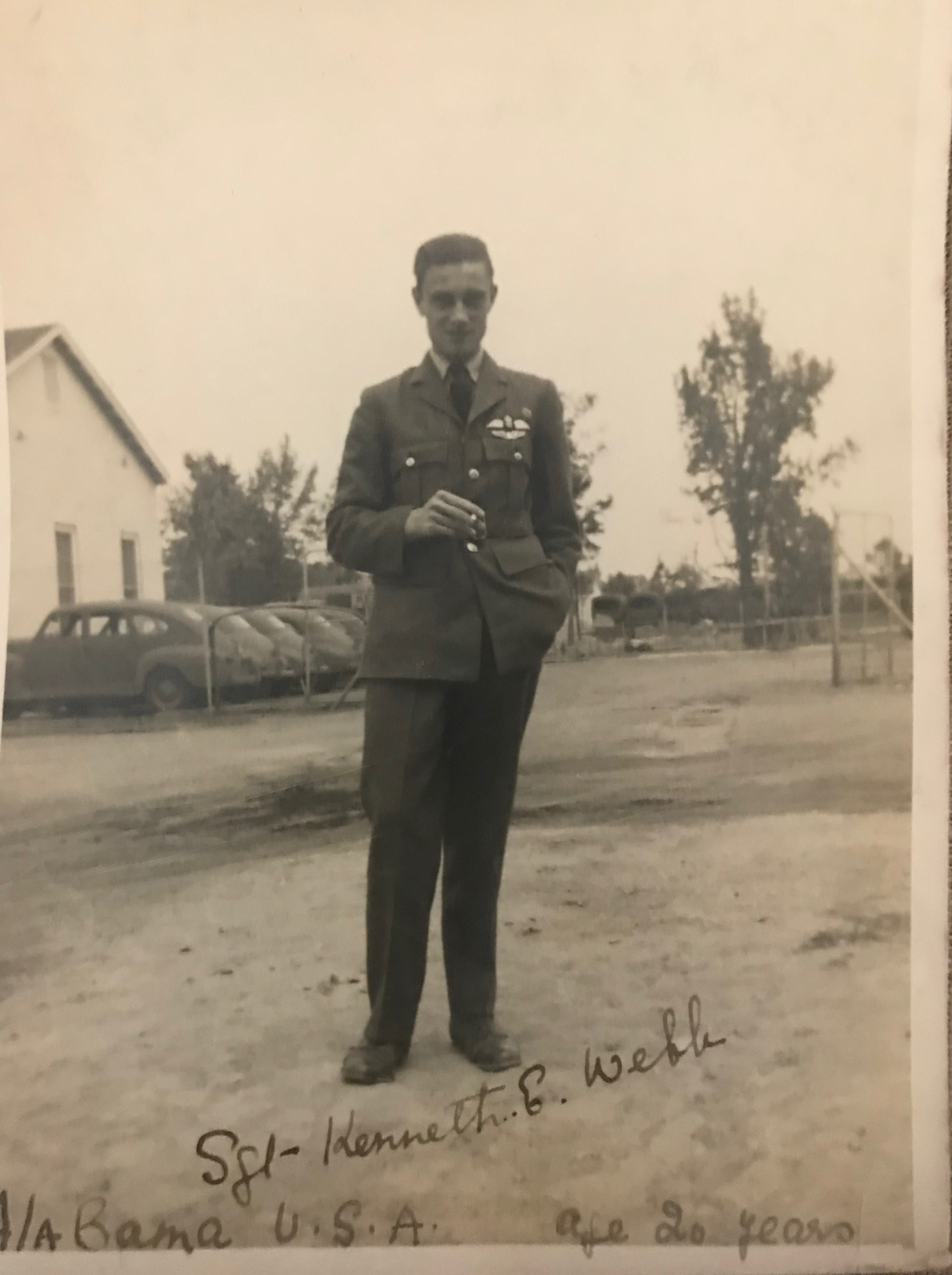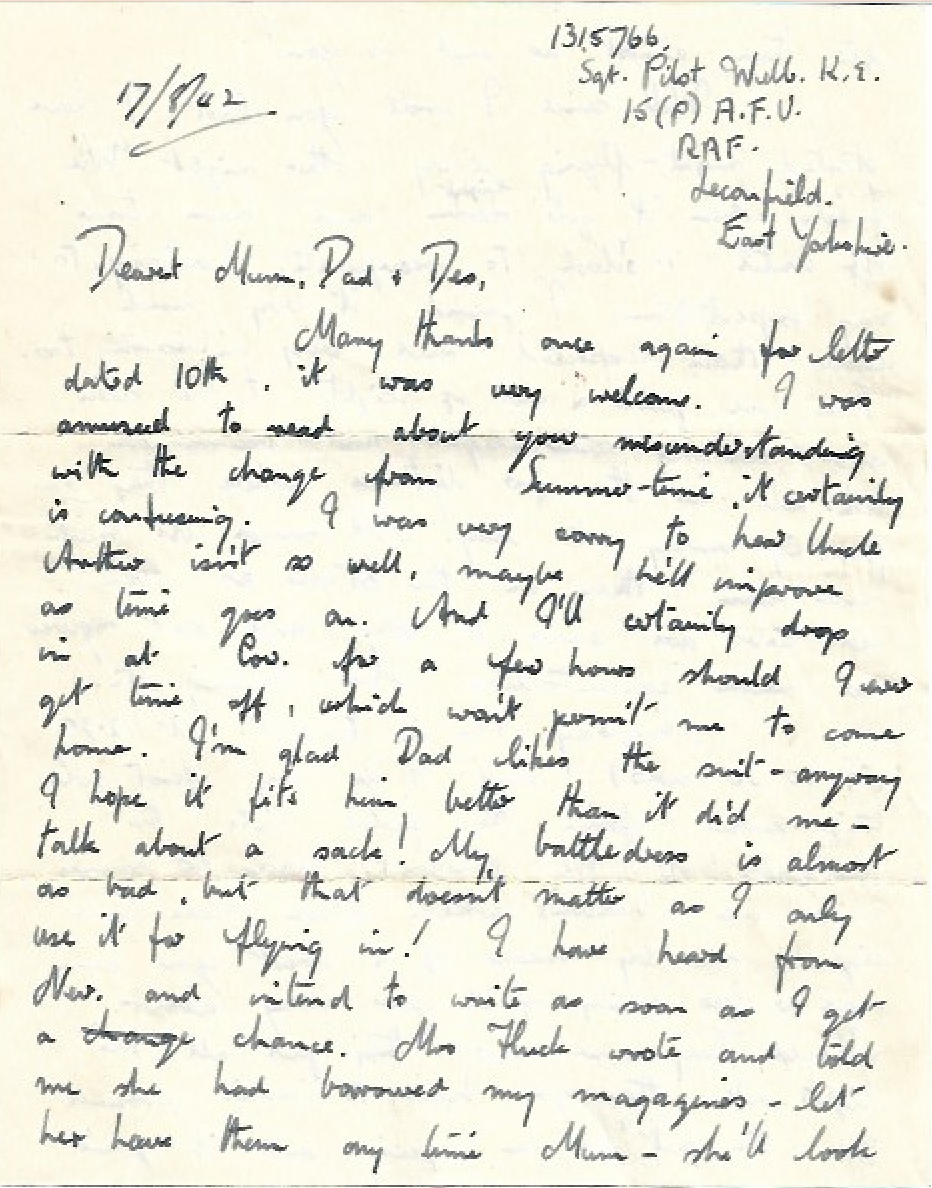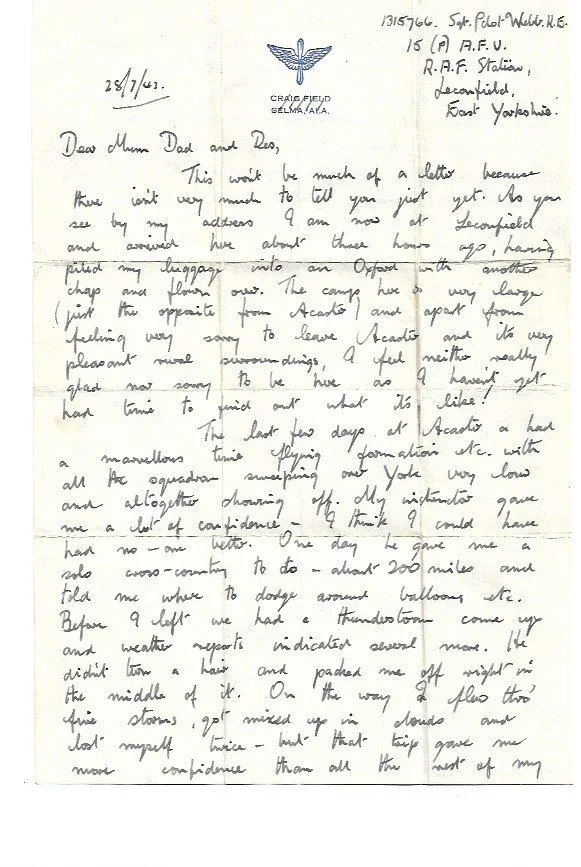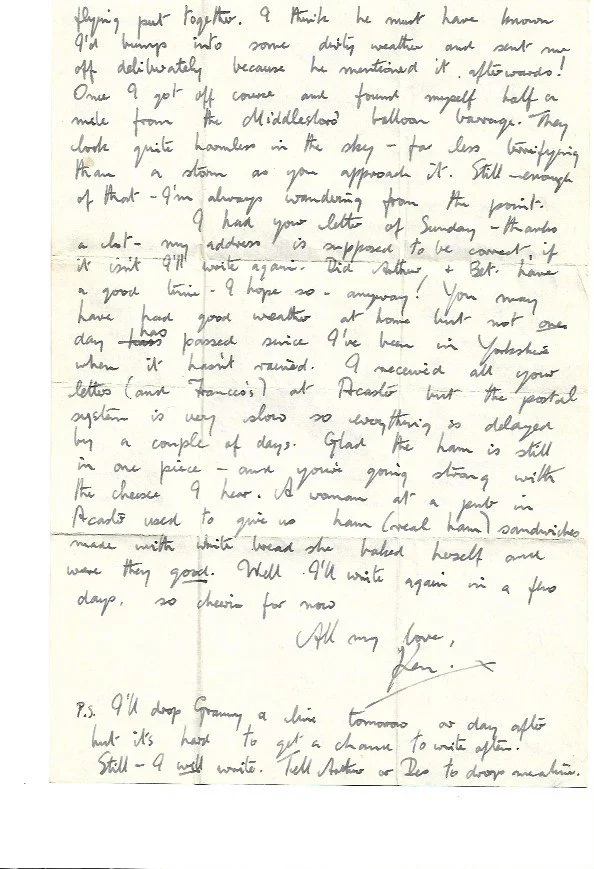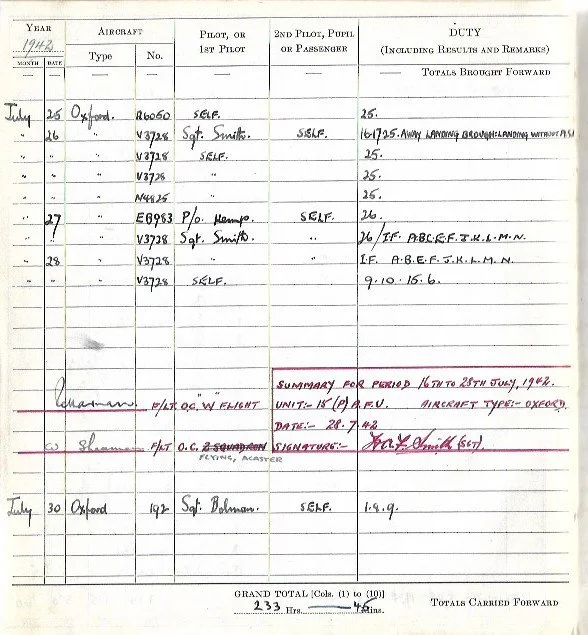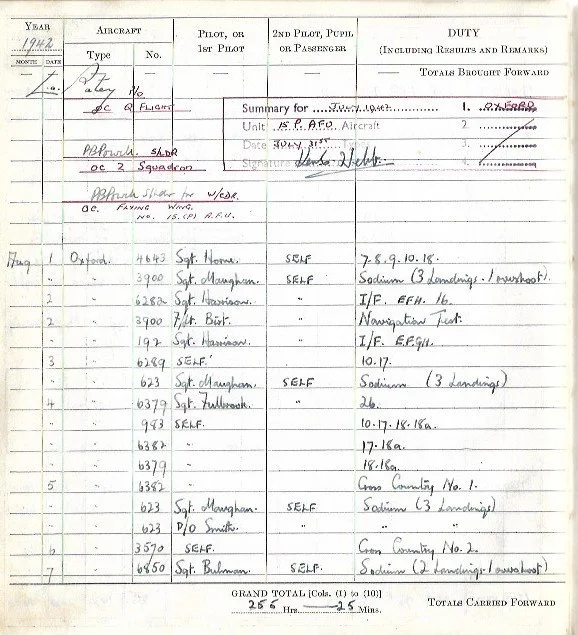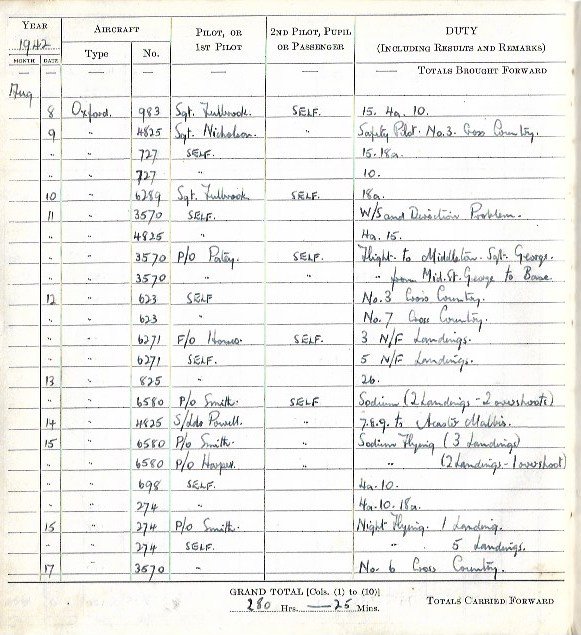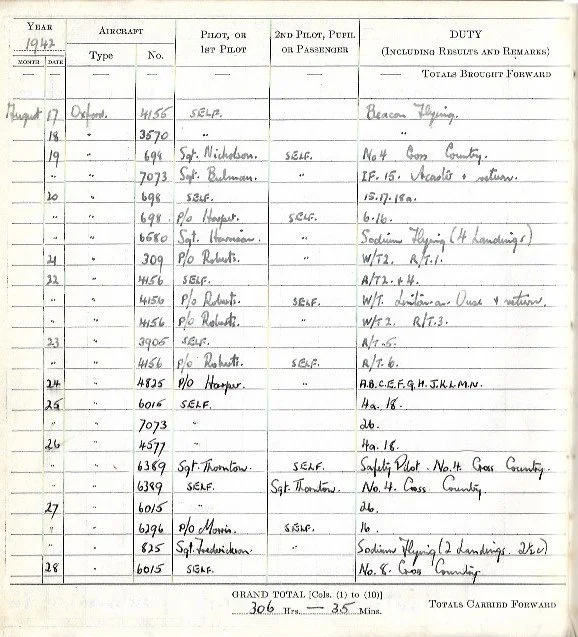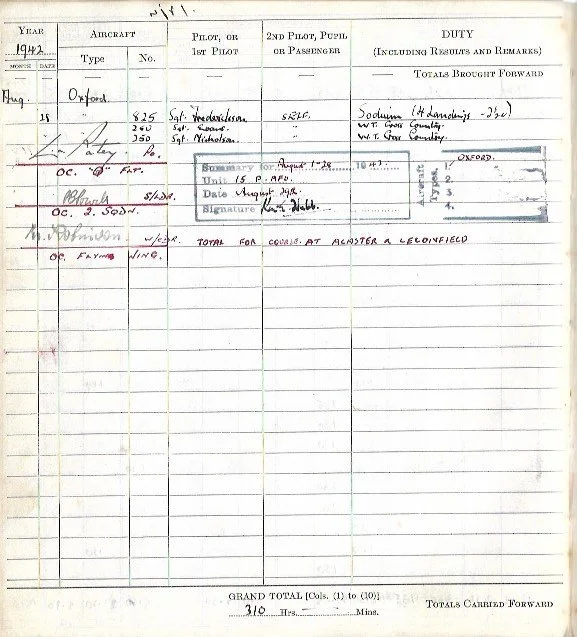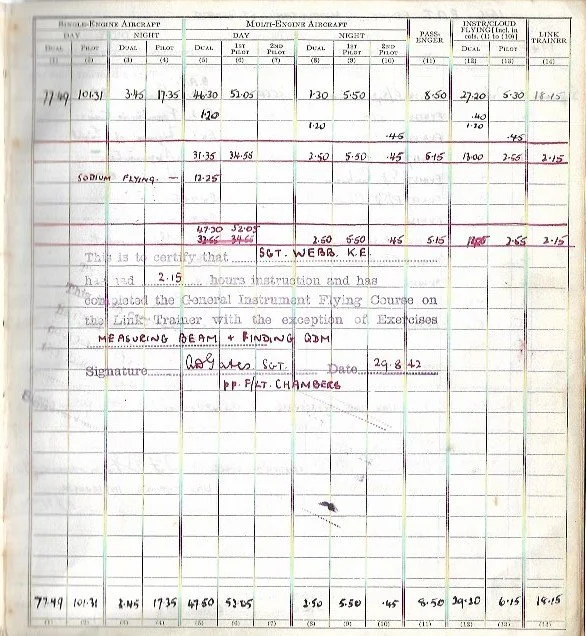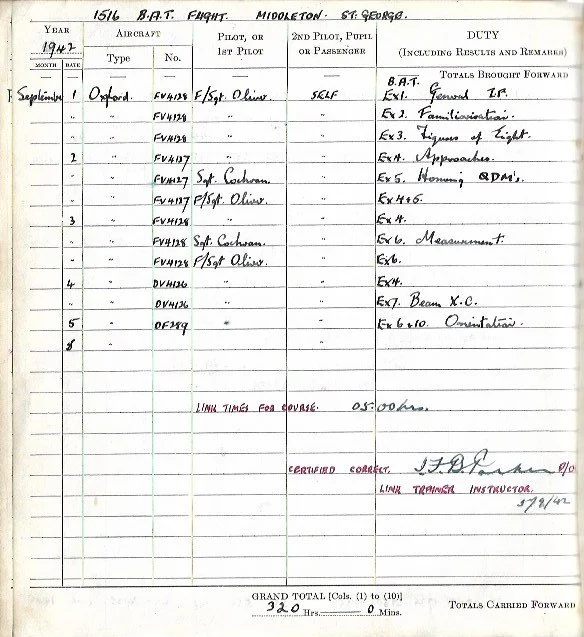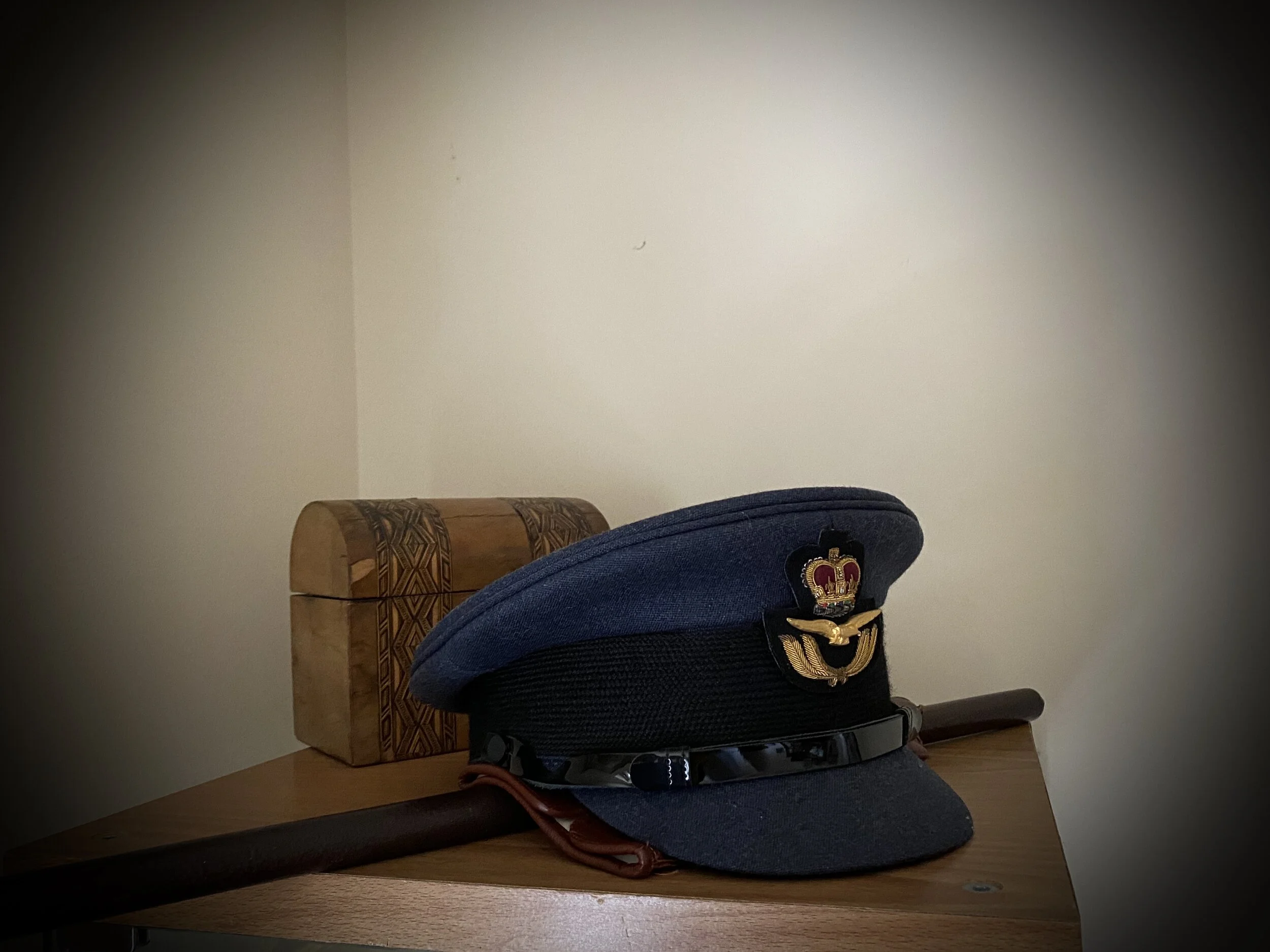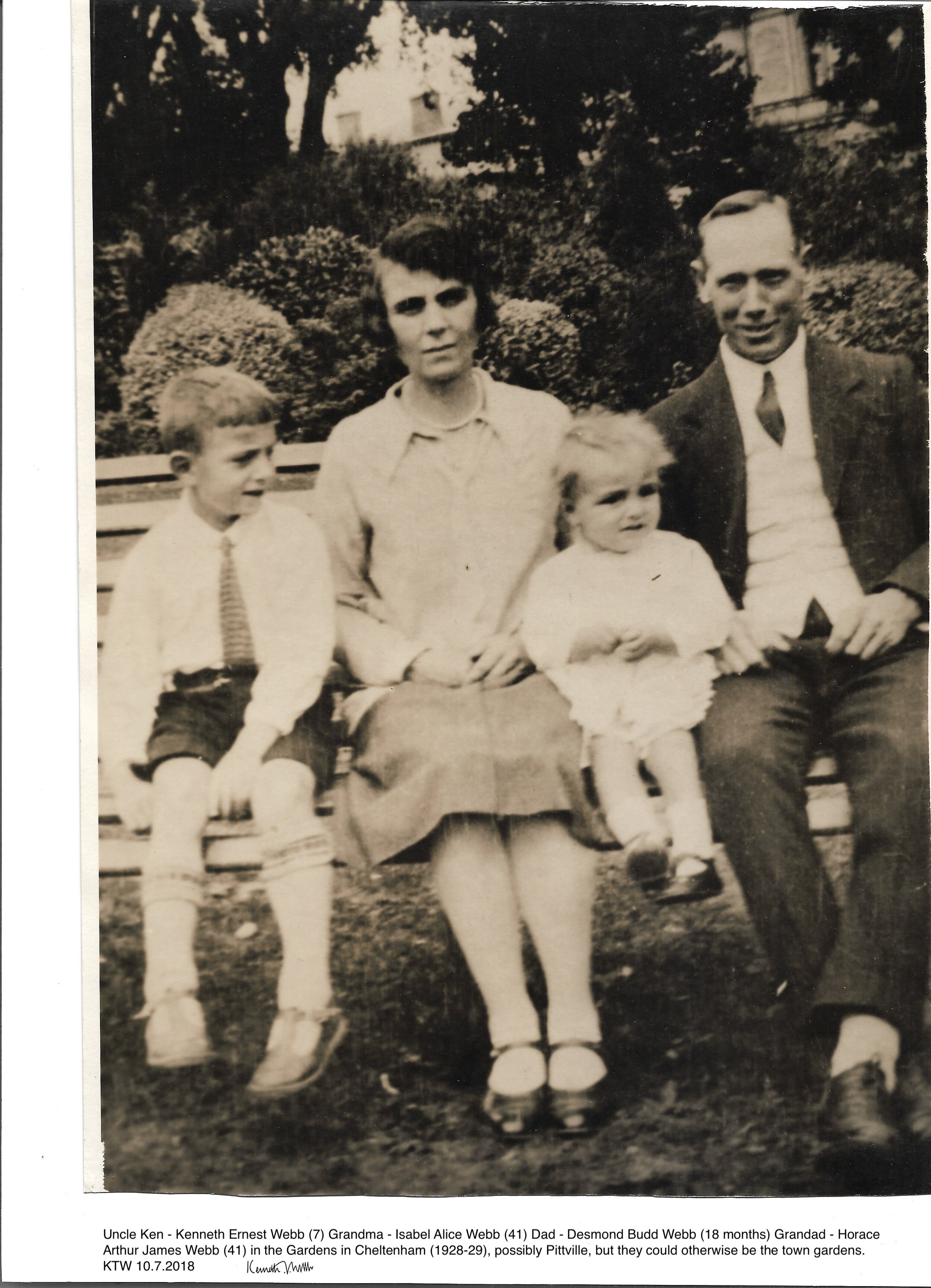WßD ~ Chapter Six : A Sergeant-Pilot and his Mum ~ A Family at War (Revised Edition) Pilot's Log

Windsor Street Days
Chapter Six
A Sergeant-Pilot and his Mum ~ a Family at War
Introduction
My father’s brother, Kenneth Ernest Webb, after whom I’m named, wrote many letters home. They provide a fascinating insight into family life, seemingly irrelevant because we live now, within this moment, but which clearly show that they, too, lived ‘within the moment’. This is so for every generation.
Working through the family archive is enjoyable, at times, demanding. Occasionally, it can be harrowing. That is so with every family the world over.
Reading the letters, I recalled Ken Webb’s observations as a twenty-year-old newly-qualified pilot, now doing night-flying training over Yorkshire with the redoubtable Airspeed twin-engine Oxford, having just returned from the USA where he had qualified.
What I like about the letter is its crispness, its lack of hostility, and the pilot’s-eye view on the tactics in use in 1942.
The transcription is exact, followed by the four scanned pages of the original letter.
The relevant left-hand pages of the Pilot’s Log for the period 16 July-28 August 1942 are also included, merely for interest and also to secure provenance.
Dearest Mum, Dad and Des,
So you see ~ it’s a cinch!!
Should Jerry come near they put all the
lights out then you have to cruise around
till they put ‘em on again and if you’re
page 3
[and if you’re] lost all that’s necessary is to fly to the nearest searchlight, flash them a certain signal and they shine the beam towards the nearest aerodrome - thus literally lighting the way home for you. So you see - its a cinch!!
RAF Log Book Analysis
Part I
The AS10 Airspeed Oxford was a twin-engine monoplane aircraft developed and manufactured by Airspeed. It saw widespread use for training British Commonwealth aircrews in navigation, radio-operating, bombing and gunnery roles throughout the Second World War. Airspeed Ltd. [i]
Examining Ken’s entries, we find that between 16 July–28 August 1942, he received extensive training both by day and night, totalling 93 flights using 40 different Airspeed Oxfords. His Log Book is signed off on 22 April 1942, that being the last page headed ‘North America’, being posted back to the United Kingdom, travelling by troopship in one of the 1942 Atlantic Convoys.
The RAF Log Book then recommences on 16 July 1942 at 15 (P) A.F.O, this being a Pilot’s Advanced Flying Unit based at RAF Leconfield in East Yorkshire (Northern Britain).
A cautionary note for myself, here. Entries can, sometimes, be misleading in military matters, because we also find that 15 (P) AFU/AFO was at various times also based at Acaster Malbis near York, and also at RAF Ramsbury in Wiltshire (Southern Britain).
At the day’s end, especially in service matters, I prefer a flexible reading of closure dates and opening dates for military and civil establishments, and of which I speak from experience.
The entries cover the period 16 July-1 September 1942, this last date provides me with confirmation of an important posting from North Yorkshire further north, still, to County Durham ~ RAF Middleton-St-George in County Durham. The really hard work then begins, as the very trusted and well-liked Airspeed Oxford moves aside for the Armstrong Whitworth Whitley, nicknamed by Crews as ‘the flying pencil’ as it was nose (or ‘lead-heavy’) heavy so that in flight the nose of the aircraft flew lower than its twin rear fins. [ii]
Part II
I sat quietly, studying the entries in the Log Book. I wanted to see what the entries might tell me about what exactly all of our aircrews were undertaking in order that they could then become fully operational. And in this regard I am only, at this stage, thinking of the pilot. Our perspective ever widens when we then consider similar training for every member of aircrew ~ flight engineer, navigator, bombardier, wireless operator and gunners.
By compiling a spreadsheet, I was able to find out a great deal of information about pilot training.
Sergeant-Pilot Kenneth Webb, based at RAF Leconfield between 15 July–31 August 1942 undertook a total of ninety-three (93) flights in forty (40) Airspeed Oxford Twin-engine Training aircraft over forty-six (46) days with sixteen (16) named flying instructors, these being eight Sergeant-Pilots, eight Junior officers and one senior officer, namely, Squadron Leader Powell, the Officer Commanding No 2 Squadron RAF.
It is essential to record their names here, for this gives a glimpse of what was happening. It also gives a respectful glance at each of these men, the work they did, and the fact - disquieting - that many would then return to operations, some surviving, many cut short in an instant. This, of course, is so with all the armed forces, but it really does come home when I look at the dire position - for us all - currently prevailing in the War in Ukraine, and the brutal Israel-Gaza War.
The letter home is dated 17 August 1942, and the Log Book confirms that Sgt-Plt Webb undertook night-flying on 15 August 1942 in Airspeed Oxford Serial No. 274 under the instruction of Pilot Officer Smith who did the first circuit and landing, whereupon Kenneth Webb became first pilot and successfully completed a further five circuits and landings.
The RAF Flying Instructors
Sergeant-Pilot Smith (1)
Sergeant-Pilot Bulman (2)
Pilot Officer Kemp (1)
Sergeant-Pilot Maugham (1)
Sergeant-Pilot Harrison (3)
Sergeant-Pilot Fullbrook (2)
Pilot Officer Smith (2)
Sergeant-Pilot Nicholson (3)
Pilot Officer Patey (2)
Flying officer Howes (2)
Sqn Ldr Powell OC, 2 Sqn RAF (1)
Pilot Officer Harper (1)
Pilot Officer Roberts (1)
Sergeant-Pilot Thornton (1)
Pilot Officer Morris (1)
Sergeant-Pilot Frederickson (1)
Flight Lieutenant Birt (1)
Name of Instructor not stated (12)
In twelve flights, the instructors are not stated, but would nevertheless have flown with their student pilot when he was instructed to fly as first pilot.
The Instructors are listed in the order that they appear in the Entries.
These 16 Instructors flew 46 flights with Sgt-Plt Webb. I mention this because this gives me just a hint at the enormous workload with which these Instructors contended, and the pressures they were under to bring trainees up to readiness for transfer to operation conversion units (OCUs), operational training units (OTUs), and then to the Heavy Conversion Units (HCUs) where pilots converted to the four engine heavy bombers. This, then, is a snapshot of just:
(a) one man undergoing advanced flying training, having qualified as a pilot in the USA in April 1942;
(b) of just one Unit of the RAF;
(c) of just one RAF Station;
(d) of 16 flying instructors
(e) of 40 Airspeed Oxford Aircraft
Our RAF Ground Crews
This leads me to that which is so often overlooked. Our Royal Air Force Ground Crews in WWII.
I find that my uncle was often flying two different aircraft on the same day. Over two days, this might run into five aircraft changes.
I am filled with awe and pride when I then think of the expertise of our engineers, armourers, technicians, aircraft repair teams and the logistics and administrative teams that interlocked with them to enable our Ground Crews to keep these forty twin-engine training aeroplanes at RAF Leconfield in fully operational condition.
The Pressures of Flying Training in Wartime
Washing chaps out!
They are still washing chaps out here, and worst of all you lose both wings and stripes. Still as long as they don’t pick on me, I’m not worrying. Now that I’m settled down here, the station doesn’t seem bad at all, quite O.K. in fact.
Airspeed Oxford
Standard cockpit layout.
Image is by courtesy of BAE Systems
Mk II Airspeed Oxford
A flight of Airspeed Oxfords in
formation in February 1942, flying from
R.A.F. Little Rissington in Gloucestershire, U.K.
The image is by courtesy of Wikipedia, of which the author is a payment subscription member.
Part I
Transcript No 1
17/8/42 1315766
Sgt. Pilot Webb. K.E.
15(P) A.F.U
RAF.
Leconfield.
East Yorkshire.
Dearest Mum, Dad & Des,
Many thanks once again for letter
dated 10th, it was very welcome. I was
amused to read about your misunderstanding
with the change from Summer-time, it certainly
is confusing. I was very sorry to hear Uncle
Arthur isn’t so well, maybe he’ll improve
as time goes on. And I’ll certainly drop
in at Cov. for a few hours should I ever
get time off, which won’t permit me to come
home. I’m glad Dad likes the suit - anyway
I hope it fits him better than it did me -
talk about a sack! My battledress is almost
as bad, but that doesn’t matter as I only
use it for flying in! I have heard from
Nev. and intend to write as soon as I get
a chance. Mrs Fluck wrote and told
me she had borrowed my magazines - let
her have them any time Mum - she’ll look
page 2
after them almost as well as you!
Well, since I wrote you last I have
started night-flying every other night. We
finish when it gets light and have time
off until 1.o’clock to recuperate. Contrary, to
my expectations I found it very much
easier than expected and very interesting too.
There are quite a lot of lights to be seen,
and usually searchlights and occasional
ack-ack in the far distance where they are
popping away at Jerry! All round its much
more fun than in the States as these
old tubs are easier to fly and don’t require
so much concentration when landing etc.
Anyway I’m on tonight at 12.30
(its 10.30 now) and I do my first solo
trip away from the field into the
darkness of the blackout. Every so many miles
are beacons which flash Morse Code
signals - so by means of a chart you can
more or less easily find your way about.
Should Jerry come near they put all the
lights out then you have to cruise around
till they put ‘em on again and if you’re
page 3
lost all that’s necessary is to fly to the nearest
searchlight, flash them a certain signal
and they shine the beam towards the nearest
aerodrome - thus literally lighting the way home
for you. So you see - its a cinch!!
Tomorrow, I have to report to the
W.T. Flight (Wireless) & spend three days learning
all the radio secrets. Its pretty good too!! Just
fly out and deliberately lose yourself and by
various ways and means they radio you a
course which brings you right back home again.
They are still washing chaps out here,
and worst of all you lose both wings and
stripes. Still as long as they don’t pick on
me, I’m not worrying. Now that I’m settled
down here, the station doesn’t seem bad at
all, quite O.K. in fact. Things have improved
considerably and the messing is much better.
Oh, by the way things are turning
out better. Today I fulfilled a long-desired
wish to see Granny’s from the air. I had
a Cross-country down to Northampton so
I spent ½ an hour scouting round till I
found Boddington. If it hadn’t been for
Byfield Pool I should never have discovered
page 4
it, as its near no railway or large river and
there are hundreds of small villages which
look all alike. Anyway I circled round it
a couple of times and had a good look.
Everything seemed the same even from 2000
feet. I couldn't go any lower as that
aerodrome isn't far away, and it's against
regulations to do so. As I don't want
to get washed out I curbed a strong desire
to buzz over it low – but it isn't worth it,
after what has happened to other chaps
who have been caught!!
Well, Mum, I want to wash
and have some supper before flying so I'll write
again next week. Give my regards to
the ‘boys’ and everyone else. Tell Arthur to
write as soon as he feels in the mood and
I'll answer Des one of these days.
Good night,
all my love,
Ken...
P,s. I'm Glad you've still got old Rex!
Has he bitten anyone else lately?
Part II
Dearest Mum, Dad and Des … page 1 August 17, 1942
Dearest Mum, Dad and Des … page 2 August 17, 1942
Dearest Mum, Dad and Des … page 3 August 17, 1942
Dearest Mum, Dad and Des … page 4 August 17, 1942
Part III
This letter is dated 28 July 1942 and precedes the above. It is, however, confirmation of Part II sub-headed ‘Our RAF Flying Instructors.’ It is also good to see the use of the U.S Army Air Corps Letterhead for Craig Field, Alabama where Ken Webb qualified. And the Logbook reference to Acaster as well as the writer’s fond memories of Acaster prompted a further online search. There is a very comprehensive Wikipedia history given of RAF Acaster Malbis, and I merely take one sentence therefrom, as it perfectly balances things for the purpose of this chapter. Unfortunately, I cannot find the name of the person or people who have provided the information, and should this come to light I will immediately accredit them:
Acaster Malbis was then used by No. 21 Group Flying Training Command as a relief landing ground for Airspeed Oxfords of No. 15 (Pilots) Advanced Flying Unit RAF ((P)AFU) from RAF Leconfield.
Transcript No 2
28/7/42 1315766
Sgt. Pilot Webb. K.E.
15(P) A.F.U
RAF.
Leconfield.
East Yorkshire.
Dear Mum Dad and Des,
This won’t be much of a letter because there isn’t very much to tell you just yet. As you see by my address, I am now at Leconfield and arrived here about three hours ago, having piled my luggage into an Oxford with another chap and flown over. The camp here is very large (just the opposite from Acaster) and apart from feeling very sorry to leave Acaster and its very pleasant raw surroundings, I feel neither really glad nor sorry to be here as I haven’t yet had time to find out what it’s like!
The last few days at Acaster had a marvellous time flying formation, etc, with all the squadron sweeping over York very low and altogether showing off. My instructor gave me a lot of confidence – I think I could have had no one better. One day he gave me a solo cross-country to do – about 200 miles and told me where to dodge around balloons, etc. Before I left, we had a thunderstorm come up and weather reports indicated several more. He didn’t turn a hair, packed me off right in the middle of it. On the way I flew through five storms, got mixed up in clouds and lost myself twice – but that trip gave me more confidence than all the rest of my
Page 2
flying put together. I think he must’ve known I’d bump into some dirty weather and sent me off deliberately because he mentioned it afterwards! Once I got off course and found myself half a mile from the Middlesbro’ balloon barrage. They look quite harmless in the sky – far less terrifying than the storm as you approach it. Still enough of that – I’m always wondering from the point.
I had your letter of Sunday – thanks a lot – my address is supposed to be correct, if it isn’t I’ll write again. Did Arthur and have a good time – I hope so – anyway! You may have had good weather at home but not one day has passed since I’ve been in Yorkshire when it hasn’t rained. I received all your letters (also Francis’s) at Acaster but the postal system is very slow so everything is delayed by a couple of days. Glad the ham is still in one piece – and you’re going strong with the cheese I hear. A woman at a pub used to give us ham (real ham) sandwiches made with white bread she baked herself and were they good! Well. I’ll write again in a few days, so cheerio for now.
All my love
Ken X
PS I’ll drop granny a line tomorrow all day after but it’s hard to get a chance to write after often. Still – I will write. Tell Arthur or Des to drop me a line.
Pilot’s Log for the period 16-25 July 1942 Sgt-Plt K E Webb, RAF Leconfield, North Yorkshire
Pilot’s Log for the period 25-30 July 1942 Sgt-Plt K E Webb, RAF Leconfield, North Yorkshire
Pilot’s Log for the period 1-7 August 1942 Sgt-Plt K E Webb, RAF Leconfield, North Yorkshire
Pilot’s Log for the period 8-17 August 1942 Sgt-Plt K E Webb, RAF Leconfield, North Yorkshire
Pilot’s Log for the period 17-28 August 1942 Sgt-Plt K E Webb, RAF Leconfield, North Yorkshire
Pilot’s Log signed off by Sgt Plt Webb and approved by Plt Off L Patey OC Q Flt, and signed off by Sqn Ldr P B Powell, OC 2 Squadron, the Log Book then being formally signed off by Wing Commander M Robinson, Officer Commanding Flying Wing, RAF Leconfield, North Yorkshire.
Sgt Plt Webb now resumes flying training at RAF Middleton St George, County Durham now progressing to the twin engine Armstrong Whitworth Whitley. This, in turn, would lead to the first operational tour on RAF Coastal Command based at RAF St Eval in Cornwall, providing air cover for convoys during The Battle of the Atlantic.
The Tea Box
As a child, this was my secret treasure trove
that had lots of priceless gems to my infant’s eye
and imagination.
Dating back to the turn of the twentieth century
and the reign of Queen Victoria, only decades
later did I surmise that Kenneth Ernest Webb
may, too, have discovered such treasure in
Windsor Street in the early 1920s…
Footnotes
[i] this is the official online description by courtesy of BAE Systems
[ii] Peter Wilson Cunliffe constructed for me in 1.72 scale, a Handley Page Halifax DK165 MP-E flown by the Webb Crew on their final operation, an Avro Lancaster PB402 LQ-M flown by the Pathfinder Payne Crew of which my mother’s brother, Flt Sgt Harry Marshall was the flight engineer, and also an Armstrong Whitworth Whitley Z9278 flown by the Webb Crew when serving on RAF Coastal Command at RAF St Eval in Cornwall. What surprised me was how large the Whitley is when I compare all three 1.72 scale models. P W Cunliffe is the author of A Shaky Do.
29 April 2024
All Rights Reserved
LIVERPOOL
©2024 Kenneth Thomas Webb
Documents are displayed by kind permission of the family.
Digital Artwork by © 2024 KTW © 2024 IBM unless otherwise credited
Last published 3 February 2022
Ken Webb is a writer and proofreader. His website, kennwebb.com, showcases his work as a writer, blogger and podcaster, resting on his successive careers as a police officer, progressing to a junior lawyer in succession and trusts as a Fellow of the Institute of Legal Executives, a retired officer with the Royal Air Force Volunteer Reserve, and latterly, for three years, the owner and editor of two lifestyle magazines in Liverpool.
He also just handed over a successful two year chairmanship in Gloucestershire with Cheltenham Regency Probus.
Pandemic aside, he spends his time equally between his city, Liverpool, and the county of his birth, Gloucestershire.
In this fast-paced present age, proof-reading is essential. And this skill also occasionally leads to copy-editing writers’ manuscripts for submission to publishers and also student and post graduate dissertations.


